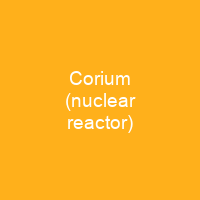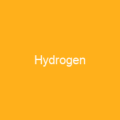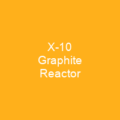Corium is a lava-like material created in the core of a nuclear reactor during a meltdown accident. It consists of a mixture of nuclear fuel, fission products, control rods, structural materials from the affected parts of the reactor, products of their chemical reaction with air, water and steam, and, in the event that the reactor vessel is breached, molten concrete. Corium of sufficient temperature can melt concrete. A solidified mass of corium can remelt if its heat losses drop.
About Corium (nuclear reactor) in brief

The balance between oxidizing and reducing chemical environments and the proportion of water and hydrogen influences the formation of chemical compounds. Variations in the volatility of core materials influence the ratio of released elements to unreleased elements. For instance, in an inert atmosphere, the silver-indium-cadmium alloy of control rods releases almost only cadmium. In the presence of water, the indium forms volatile indium oxide and indium hydroxide, which can evaporate and form an aerosol. Caesium and iodine from the fission product can react to produce volatile caesium iodide. The gaseous compounds may be adsorbed on the surface of the aerosol particles. There are differences between pressurized water reactor and boiling water reactor coriums. The composition of coriam depends on the design type of reactor, and specifically on the materials used in the control rods and coolant and reactor vessel structural materials. The heat production from radioactive decay drops quickly, as the short half-life isotopes provide most of the heat and radioactive decay, with the curve of decay heat being a sum of the decay curves of numerous isotopes of elements decaying at different exponential half- life rates. A significant additional heat source can be the chemical reaction of hot metals with oxygen or steam.
You want to know more about Corium (nuclear reactor)?
This page is based on the article Corium (nuclear reactor) published in Wikipedia (as of Dec. 05, 2020) and was automatically summarized using artificial intelligence.







